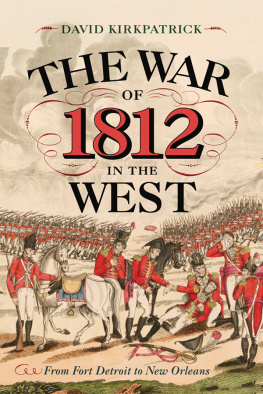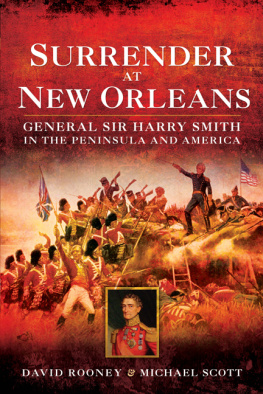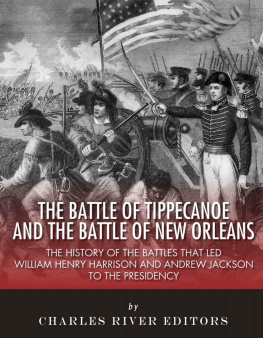The War of 1812, Conflict and Deception

This book was published in cooperation with the
BATTLE OF NEW ORLEANS BICENTENNIAL COMMISSION

This book is made possible in part by a generous contribution from
KEN and FRED ATCHITY
and with the assistance of the
V. RAY CARDOZIER FUND
The WAR of 1812
CONFLICT AND DECEPTION
The British Attempt to Seize New Orleans
and Nullify the Louisiana Purchase

RONALD J. DREZ
With a Foreword by W. HENSON MOORE

LOUISIANA STATE UNIVERSITY PRESS
BATON ROUGE
Published by Louisiana State University Press
Copyright 2014 by Ronald J. Drez
All rights reserved
Manufactured in the United States of America
First printing
Designer: Barbara Neely Bourgoyne
Typeface: MillerText
Printer and binder: Maple Press
Library of Congress Cataloging-in-Publication Data
Drez, Ronald J., 1940
The War of 1812, conflict and deception : the British attempt to seize New Orleans and nullify the Louisiana Purchase / Ronald J. Drez.
pages cm
Includes bibliographical references.
ISBN 978-0-8071-5931-6 (cloth : alk. paper) ISBN 978-0-8071-5932-3 (pdf) ISBN 978-0-8071-5933-0 (epub) ISBN 978-0-8071-5934-7 (mobi) 1. United States HistoryWar of 1812. 2. New Orleans, Battle of, New Orleans, La., 1815. I. Title.
E354.D74 2015
973.5'2dc23
2014020834
The paper in this book meets the guidelines for permanence and durability of the Committee on Production Guidelines for Book Longevity of the Council on Library Resources.
Dedicated to Roger and Aline Drez,
who made this all possible
CONTENTS
FOREWORD
Good works on American history come and go. Hopefully we learn from them, and sometimes we learn something new. I am very excited about this work as not only will the reader learn, but it actually changes history. Not many books can make that claim.
When the Battle of New Orleans Bicentennial Commission was created, its founding legislation envisioned twin missions of celebration and education. No one knew then of the possibility of actually rewriting what we have learned in the past about the Battle of New Orleans. We have all been taught that Gulf of Mexico campaign during the War of 1812 culminated in the conflict that took place on January 8, 1815. While a tremendous and unexpected military victory for Jackson and the United States, the battle, as we have also been told, was actually unnecessary as the Treaty of Ghent had been signed on December 24, 1814, effectively ending the war. If generals Jackson and Packenham had modern communications available to them, the battle would never have been fought. This conclusion of historians has probably done more than anything else to relegate this once celebrated event to the dustbin of American history. At one time, January 8 was one of only two national holidays, July 4 being the other.
But what if this was not true? What if the battle was going to be fought by the aggressor even if he knew about the treaty? What if he had orders to do so even in the event of a treaty? Would history be wrong? Would this change history and restore this magnificent battle to the pantheon of our great national events? You must read on, learn the truth, and make up your own mind about the new history of the Battle of New Orleans.
The new material revealing the necessity of the battle itself notwithstanding, this book is an excellent telling in a very readable style of the events leading up to this climactic nineteenth-century confrontation between David and Goliath. You will undoubtedly enjoy it and learn more than you ever knew about this last crossing of swords by two countries that have remained strong allies ever since.
The author is an accomplished military history writer and indefatigable researcher. This may be his greatest work because he does change history. This may also be the greatest leave-behind of the bicentennial of this truly historic battle.
W. HENSON MOORE
Chairman, Battle of New Orleans Bicentennial Commission
ACKNOWLEDGMENTS
This book was initially made possible through the efforts of Louisiana State Representative Nicholas Lorusso, whose passion for history inspired him to commemorate the series of battles of the War of 1812 collectively referred to as the Battle of New Orleans.
He introduced legislation stating that the bicentennial of the Battle of New Orleans be recognized and celebrated, particularly between December 23, 2014, and January 8, 2015the dates during which the United States and Great Britain fought the climactic battle of the War of 1812 two centuries ago. That legislation created the Battle of New Orleans Bicentennial Commission to commemorate this anniversary through local and statewide observances, educational events, and activities planned, coordinated, and conducted by a commission for such a purpose.
The Honorable Henson J. Moore, formerly a Louisiana member in the United States House of Representatives, graciously accepted the challenge to chair this commission. In an effort to fulfill the commissions charge to create a new, complete work on the war and the Battle of New Orleans, I worked under its guidelines to produce a book that would truly be accurate, commemorative, and educational. I am indebted to Dr. Gary Joiner, the Chairman of the history department at LSU in Shreveport, who painstakingly reviewed the work for its scope and contribution to the subject of the War of 1812.
The professionals at LSU Press, under the leadership of director Mary-Katherine Callaway, have all contributed their talents to bring the book to life, and it has been a pleasure to work with them.
I owe a special thanks to Mary Lee Berner Harris, the curator of the Ursuline Convent Collection in New Orleans, for the documents and research that detailed the vital relationship between the Ursuline nuns, the battle, General Andrew Jackson, and the city of New Orleans. Finally, a special thanks to my wife, Judy, who continually combed through the manuscript to find better words to tell this remarkable story.
TIME LINE FOR LOUISIANA
1682. Robert Cavelier de LaSalle claims the Mississippi River and the land drained by the river for Louis XIV and names it Louisianathe Land of Louis.
1718. New Orleans is founded by Jean Baptiste Lemoyne de Bienville.
1722. New Orleans becomes the capital of the vast Louisiana Territory.
1762. Following the British victory in the French and Indian War, or the Seven Years War, France secretly cedes to Spain the Louisiana territory west of the Mississippi River, including New Orleans, in the Treaty of Fontainebleau. This was to avoid losing the land to the victorious British. New Orleans falls under Spanish rule.
1763. The Treaty of Paris officially ends the Seven Years War, and France cedes the eastern half of Louisiana to Great Britain. This is the area between the Mississippi River and the Appalachian Mountains. Spain also cedes East and West Florida to Great Britain, but New Orleans remains under Spanish rule.
1783. The Treaty of Paris ends the seven-year American Revolution, and Great Britain is forced to cede the eastern half of Louisiana to the United States and the colonies of East and West Florida back to Spain. The narrow strip of land south of the 31st parallel and north of the Gulf of Mexico is divided by the Apalachicola River. The capital of East Florida is St. Augustine, and West Floridas capital is Pensacola. New Orleans remains under the Spanish flag. The western and southern boundaries of the United States are now controlled by Spain. Great Britain retains perpetual access to the Mississippi River.
Next page











